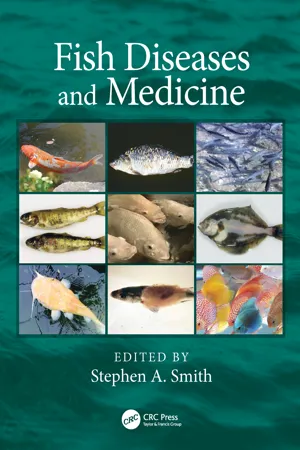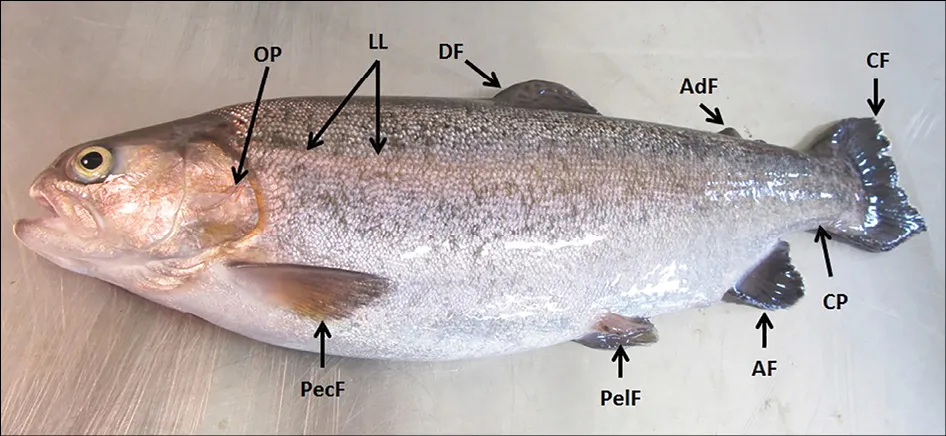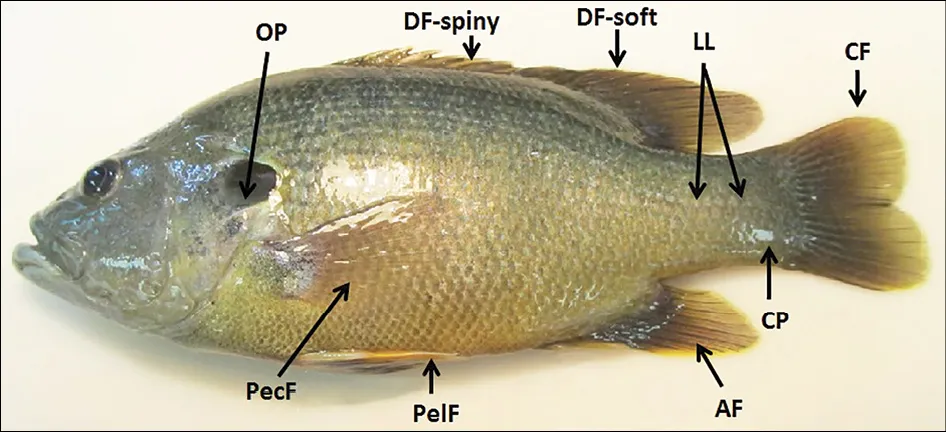
- 328 pages
- English
- ePUB (mobile friendly)
- Available on iOS & Android
eBook - ePub
Fish Diseases and Medicine
About this book
Fish are critically important to the welfare of this planet and its occupants, the health of both wild and captive fish populations paramount to our survival. This book presents the gross pathology of the most commonly encountered diseases and syndromes of fish in an organ system-based approach. It provides an overview of the di
Frequently asked questions
Yes, you can cancel anytime from the Subscription tab in your account settings on the Perlego website. Your subscription will stay active until the end of your current billing period. Learn how to cancel your subscription.
No, books cannot be downloaded as external files, such as PDFs, for use outside of Perlego. However, you can download books within the Perlego app for offline reading on mobile or tablet. Learn more here.
Perlego offers two plans: Essential and Complete
- Essential is ideal for learners and professionals who enjoy exploring a wide range of subjects. Access the Essential Library with 800,000+ trusted titles and best-sellers across business, personal growth, and the humanities. Includes unlimited reading time and Standard Read Aloud voice.
- Complete: Perfect for advanced learners and researchers needing full, unrestricted access. Unlock 1.4M+ books across hundreds of subjects, including academic and specialized titles. The Complete Plan also includes advanced features like Premium Read Aloud and Research Assistant.
We are an online textbook subscription service, where you can get access to an entire online library for less than the price of a single book per month. With over 1 million books across 1000+ topics, we’ve got you covered! Learn more here.
Look out for the read-aloud symbol on your next book to see if you can listen to it. The read-aloud tool reads text aloud for you, highlighting the text as it is being read. You can pause it, speed it up and slow it down. Learn more here.
Yes! You can use the Perlego app on both iOS or Android devices to read anytime, anywhere — even offline. Perfect for commutes or when you’re on the go.
Please note we cannot support devices running on iOS 13 and Android 7 or earlier. Learn more about using the app.
Please note we cannot support devices running on iOS 13 and Android 7 or earlier. Learn more about using the app.
Yes, you can access Fish Diseases and Medicine by Stephen A. Smith in PDF and/or ePUB format, as well as other popular books in Médecine & Physiologie. We have over one million books available in our catalogue for you to explore.
Information
Chapter 1
Anatomical Physiology of Fish
Christine L. Densmore
As veterinarians and animal health professionals, we are trained to deal with a very diverse group of creatures. We receive formal training in the life history, physiology and medicine specific to a wide variety of animals, and we address these differences by subdividing the field in a phylogenic approach that is largely species based. When approaching a case, we generally think in terms of canine, feline, equine, bovine, etc. medicine, and the differential diagnoses, diagnostic options, and therapeutic regimes and doses are recalled and considered based on those types of categorizations. Other groupings of animals may be approached by the typical veterinary practitioner with an even broader perspective. For instance, small mammal medicine incorporates many mammalian orders, including species of rodents, lagomorphs and mustelids, whereas avian medicine covers an entire class of the phylum Vertebrata. Given this perspective, piscine medicine can present even greater challenges in terms of physiological and morphological diversity among the subject matter and the patients. “Fish” span three classes of vertebrates and represent well over 33,000 individual species, more species than are contained in all the other classes of vertebrates combined. The life spans of fish can be measured in days in some instances or may exceed a century in others. The habitat of a fish may be an isolated pool of water in a desert climate or the deepest unexplored region of the ocean floor. Adult sizes among fish species range from less than 1 centimeter to approximately 15 meters in total length. Diversity among fish is truly amazing.
Looking up the word “fish” in a dictionary, one is likely to find a definition that describes a cold-blooded, limbless animal that is covered with scales, lives exclusively in water, and obtains oxygen from that water through its gills. Although this is generally accurate, there are a number of fish species that defy one or more of each of these descriptors. So how may we accurately define a fish? Taxonomically, they are members of the subphylum Vertebrata and one of three classes or superclasses of vertebrates: Agnatha (jawless fish like the lamprey), Chondrichtyes (cartilaginous fish including the sharks, skates, and rays, also known as elasmobranchs) or Osteichthyes (bony fish that include the majority of the more familiar species). They all have gills throughout their entire lives and generally live exclusively in (or at least rely heavily upon) an aqueous environment. Some like the arapaima, snakehead and some catfish actually do breathe air to the point that they may survive for a time out of water. Fish are generally motile, utilizing fins and lateral undulation to help with locomotion through water and, in rare cases with a few species, on land or other firm substrate. Most fish are ectothermic, or cold-blooded, with their body temperature solely dependent upon the environmental temperature. There are, however, noted exceptions that maintain their body temperature above environmental temperature including large pelagic species like the bluefin tuna (Thunnus thynnus) and deep-diving species like the opah (Lampris sp.).
This overview of anatomic physiology therefore cannot begin to cover the immense diversity of form and function that is found among fish. Instead, this chapter will endeavor to highlight the major consistencies and differences that are evident in the anatomy and physiology of those fish most likely to be encountered by the veterinarian or biologist working in the realm of aquatic animal health. The majority of this chapter will describe teleost fish, members of the infraclass Teleostei that includes bony fish with protrusible upper jaws, as these represent the majority of species commonly encountered in clinical or research settings. Attention will also be given to the more commonly encountered non-teleost fish including other bony fish like lungfish, sturgeons, and gars as well as the elasmobranchs.
External anatomy
Collectively, fish provide an excellent illustration of how in the biological sciences, form follows function. Size, body conformation and other external features that characterize a species are strongly linked to environmental demands. Like other vertebrate animals, fish display bilateral symmetry and their body contour is related to their life history (Figures 1.1 through 1.3). Pelagic fish that expend considerable energy swimming will tend to be fusiform in shape, schooling fish that turn and maneuver in tandem may tend to be more laterally compressed, and benthic dwellers will frequently exhibit dorsoventral compression. Morphological specialization with regard to ecological niche is highly evident among fish. The serpentine body form of eels, the torpedo-like shape that renders quick and agile movement to ambush predators like the pike, and even the bizarre but aesthetically pleasing appearance of syngnathids like seahorses and sea dragons are examples. In general, however, there are a number of external anatomical landmarks that are well conserved among fish. Fish may be subdivided into three anatomical regions: head, body, and tail. Familiar landmarks on the fish’s head include the mouth, nares and eyes. Many types of fish will also have special adaptive features evident on the head region, such as the barbels of catfish, sturgeon and cyprinids, or the extended spikey rostrum of sawfish (Figure 1.4). Separating the head from the body regions, most species will have bilaterally paired opercula, motile flaplike coverings that protect the gills beneath and function in the mechanics of respiration. Among the elasmobranchs, gill slits are present and opercula are not. Ventral and posterior on the body in some species is a cloaca, the chamber that receives duct outlets from the gastrointestinal, excretory and reproductive systems. Some species have separate distal openings to these organ systems that are grossly apparent, examples of which include the anus or urinary and genital pores/papillae. Behind the cloaca or pores, the body of most fish narrows into the caudal peduncle and the associated fin that forms the tail.

Figure 1.1 External anatomy of the rainbow trout (Oncorhynchus mykiss). OP, operculum; LL, lateral line; PecF, pectoral fin; PelF, pelvic fin; DF, dorsal fin; AF, anal fin; AdF, adipose fin; CF, caudal fin; CP, caudal peduncle. (Image courtesy of E. Nadenbousch.)

Figure 1.2 External anatomy of the green sunfish (Lepomis cyanellus). OP, operculum; LL, lateral line; PecF, pectoral fin; PelF, pelvic fin; DF, dorsal fin; AF, anal fin; CF, caudal fin; CP, caudal peduncle. (Image courtesy of E. Nadenbousch.)

Figure 1.3 External anatomy of the chain dog fish (Scyliorhinus rotifer). Sp, spiracle; GS, gill slits; LL, lateral line; PecF, pectoral fin; PelF, pelvic fin; DF, dorsal fin; AF, anal fin; CF, caudal fin; CP, caudal peduncle. (Image courtesy of S. Boylan.)

Figure 1.4 Maxillary barbels on the head of a common carp. These paired special sensory features are located near the mouth in some fish species and are associated with tactile and gustatory sensations. (Image courtesy of S.A. Smith.)
The fin of the fish is the familiar piscine appendage that primarily functions in locomotion. Like the fish themselves, fins come in a varied combination o...
Table of contents
- Cover
- Half Title
- Title Page
- Copyright Page
- Dedication
- Contents
- Preface
- Editor
- Contributors
- Additional Image Contributors
- 1. Anatomical Physiology of Fish
- 2. Water Quality and Environmental Issues
- 3. Diagnosis of Fish Diseases
- 4. Ocular Disorders
- 5. Skin and Fin Diseases
- 6. Gill Diseases
- 7. Musculoskeletal Diseases
- 8. Coelomic Disorders
- 9. Gastrointestinal Disorders
- 10. Cardiac Diseases
- 11. Hepatic, Biliary, and Pancreatic Diseases
- 12. Renal Diseases and Disorders
- 13. Swim Bladder Disorders
- 14. Reproductive Disorders
- 15. Neurological Diseases
- 16. Nutritional Diseases
- 17. Sedation, Anesthesia, Analgesia and Euthanasia
- 18. Surgery
- 19. Therapeutants for Fish
- Appenidx A: Therapeutics for Ornamental, Tropical, Bait and OtherNon-Food Fish: Antimicrobial and Antifungal Agents
- Appendix B: Therapeutics for Ornamental, Tropical, Bait and Other Non-Food Fish: Antiparasiticides
- Appendix C: Therapeutics for Ornamental Fish, Tropical, Bait and Other Non-Food Fish: Supportive Therapy and Care
- Appendix D: Example of Cascade System in United Kingdom
- Appendix E: References for Drugs used in Aquaculture in Other Countries
- Index